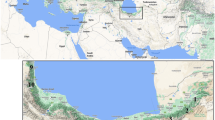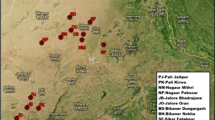Abstract
Rhododendron arboreum of the family Ericaceae represents one of the ancient relict tree species of the genus showing extreme disjunction in the Indian subcontinent. It is represented by two sub-species viz., ssp. arboreum Smith in the forests of north-eastern India (temperate) and spp. nilagiricum (Zenker) Tagg distributed in the southern Western Ghats (tropical) of India with apparently no distribution in the intervening plains. 35 Samples corresponding to different locations in the tropical montane forests of Nilgiris and temperate forests of northeast India were analyzed for distribution of genetic variation using 25 random primers. Relatively high genetic diversity was measured in the temperate populations (Ht = 0.21; Nm = 1.13) than tropical Rhododendrons. The hierarchical analysis of molecular variance showed that among the total variance, 25% is residing within populations while 63% of variance is among regions apparently revealing that disjunct distribution has structured genetic differentiation pattern in this species. Grouping of samples was in conformity with their spatial distribution, which was confirmed by UPGMA cluster analysis and PCA scatter plot. The taxon with its unique distribution pattern and wide cross compatibility between sub-species is however threatened by low genetic variation and gene flow that catalyses it’s shifting towards genetic drift and hence long-term conservation strategies need to be formulated particularly for the tropical Rhododendron sub-species. Among the various hypotheses and theory proposed to explain the Malayan affinity in the flora and fauna of Western Ghats, Satpura hypothesis based on dispersal model of distribution largely explains the discontinues distribution of R. arboreum.
Similar content being viewed by others
Abbreviations
- NEI:
-
North-East India
- SWG:
-
outhern Western Ghats
References
Ajay J.P., Elahi S., Arvind J., Bhaskar A. & Virendra K. 2001 Reproductive behaviour and genetic variability in geographically isolated populations of Rhododendron arboreum (Ericaceae) Curr. Sci. 79: 1377–1381
Andersson L. 1986. The driving force: species concepts and ecology Taxon 39: 375–382
Apte G.S., Bahulikar R.A., Kulkarni R.S., Lagu M.D., Kulkarni B.G., Suresh H.S. & Gupta V.S. 2006. Genetic diversity analysis in Gaultheria fragrantissima Wall. (Ericaceae) from the two biodiversity hotspots in India using ISSR markers. Curr Sci. 91(12): 1634–1640
Bahulikar R.A., Lagu M.D., Kulkarni B.G., Pandit S.S., Suresh H.S., Rao M.K.V., Ranjekar P.K. & Gupta V.S. 2004. Genetic diversity among spatially isolated populations of Eurya nitida Korth. (Theaceae) based on inter-simple sequence repeats Curr. Sci. 86: 824–831
Burkil J.H. 1924. The botany of Abor expedition. Rec. Bot. Surv India 10: 420
Chamberlain D.F., Hyam R., Argent G., Fairweather G. & Walter K.S. 1996. The genus Rhododendron its classification and synonymy. Royal Botanical Garden, Edinburgh, 181 pp
Chandra Sekar K. & Sunil Kumar S. 2010. Rhododendrons in Indian Himalayan Region: Diversity and Conservation. Am J. Plant Sci. 1: 131–137
Charlesworth B., Morgan M.T. & Charlesworth D. 1993. The effect of deleterious mutations on neutral molecular variation Genetics 134: 1289–1303
Dilger W.C. 1952. The Brij hypothesis as an explanation for the tropical faunal similarities between the Western Ghats and the eastern Himalayas, Assam, Burma and Malaya. Evolution 6: 125–127
Fyson P.F. 1932. The Flora of the South Indian Hill Station Government Press, Madras, 697 pp
Gamble J.S. & Fischer C.E.C. 1915. Flora of Presidency of Madras. Adlard and Son Ltd, London, Vol. 1–3
Giriraj A., Irfan-Ullah M., Ramesh B.R., Karunakaran P.V., Anke J. & Murthy M.S.R. 2008. Mapping the potential distribution of Rhododendron arboreum Smith. spp. nilagiricum (Zenker) Tagg (Ericaceae), an endemic plant using ecological niche modelling. Curr. Sci. 94(12): 1605–1612
Gupta H.P. 1990. Sholas in south Indian montane: past, present and future. Paleobotanist 38: 394–403
Hora S.L. 1937. Distribution of Himalayan fishes and its bearing on certain palaeogeographical problems. Rec. Ind. Mus. 42: 365–374
Hora S.L. 1944. On the Malayan affinities of the fresh-water Fish-Fauna of peninsular India, and its bearing on the probable age of the Garo-Rajmahal gap. Proceedings of the National Institute of Sciences of India 15: 362–364
Hora S.L. 1949. Symposium on Satpura hypothesis of the distribution of the Malayan fauna and flora in peninsular India Proc. Nat. Inst. Sci. India 15: 309–314
Jayanthi M. & Seeni S. 2000. Analysis of Natural Intraspecific Variation in Rhododendron nilagiricum Zenk of Nilgiris using RAPD. J. Plant Biochem. Biotechnol. 9: 103–106
Loretta G., Eckert A.J. & Hall B.D. 2005. The molecular systematics of Rhododendron (Ericaceae): A phylogeny based upon RPB2 gene sequences. Syst. Bot. 30(3): 616–626
Lynch M. & Milligan B.G. 1994. Analysis of population genetic structure with RAPD markers. Mol. Ecol. 3: 91–99
Mao A.A., Singh K.P. & Hajra P.K. 2001. Rhododendron. In: Singh N.P. & Singh D.K. (eds), Florestic diversity and conservation strategies in India BSI Kolkata 4: 2167–2202
Mayr E. 1982. The growth of biological thought: diversity, evolution, and inheritance. Belknap Press of Harvard University, Cambridge
Medlicot H.G. & Blanford W.T. 1879. A Manual of Geology of India, Calcutta 2
Meher-Homji V.M. 1972. Himalayan plants on South Indian hills: Role of Pleistocene glaciation vs. long distance dispersal. Sci Cult. 38: 8–12
Michael C.W. & David E.M. 1999. Indirect measures of gene flow and migration: FST ≠ 1/(4Nm+1). Heredity 82: 117–125
Milne R.I. 2006. Northern Hemisphere plant disjunctions: a window on tertiary land bridges and climate change? Ann Bot. 98(3): 465–472
Murray M.G. & Thompson W.F. 1980. Rapid isolation of highmolecular-weight plant DNA. Nucl. Acid Res. 8: 4321–4325
Nei M. 1973. Analysis of gene diversity in subdivided populations Proc. Natl. Acad. Sci. 70: 3321–3323
Peakall R. & Smouse P.E. 2006. GENALEX 6: genetic analysis in Excel. Population genetic software for teaching research Mol. Ecol. Notes 6: 288–295
Real L.A. 1994. Ecological genetics. Princeton University Press, Princeton, NJ
Sai C.N.G. & Richard T.C. 2000. Genetic variation and structure in six Rhododendron species (Ericaceae) with contrasting local distribution patterns in Hong Kong, China. Mol. Ecol. 9: 956–969
Singh K.K., Kumar S., Rai L.K. & Krishna A.P. 2003. Rhododendrons conservation in the Sikkim Himalaya. Curr. Sci. 85: 602–606
Sleumer H. 1966. An account of Rhododendron in Malesia. Flora Malesiana, Series 1(6): 469–674
Sofia Banu., Lagu M.D. & Gupta V.S. 2010. Phylogeographical studies in disjunct populations of Symplocos laurina Wall. using cytoplasmic PCR-RFLP approach. Tree Genet. Genomes 6: 13–23
Tamura K., Dudley J., Nei M. & Kumar S. 2007. MEGA 4, Molecular evolutionary genetics analysis (MEGA) software version 4.0. Mol. Biol. Evol. 24(8): 1596–1599
Udai C.P. & Sonam T.L. 1990. Sikkim-Himalayalan Rhododendrons Primulaceae books, Thomson Press, India
Van Valen L. 1976. Ecological species, multispecies, and oaks Taxon 25: 233–239
Vetaas O. R. 2000. Separation of subspecies along a temperature gradient, pp. 28–31. Proceedings IAVS Symposium Opulus Press, Uppsala
Wright S. 1931. The genetic structure of populations. Ann. Eugenetics 16: 97–159
Yan C.H., Cai A.T., Gituru R.W., Ming Q.Z., Zhong L.H. & Yun C.S. 2009. Mating system and genetic diversity in natural populations of Nelumbo nucifera (Nelumbonaceae) detected by ISSR markers. Plant Syst. Evol. 277: 13–20
Yap I.V. & Nelson R.J. 1996. In WinBoot-A programme for performing bootstrap analysis for binary data to determine the confidence limits of UPGMA based dendrograms. Discussion paper series number 14, International Rice Research Institute, Manila
Yeh F.C., Yang R.C., Boyle T.B.J., Ye Z.H. & Mao J.X. 1997 POPGENE, the user-friendly software for population genetic analysis. Molecular Biology and Biotechnology Centre, University of Alberta, Edmonton, Canada
Author information
Authors and Affiliations
Corresponding author
Rights and permissions
About this article
Cite this article
Kuttapetty, M., Pillai, P.P., Varghese, R.J. et al. Genetic diversity analysis in disjunct populations of Rhododendron arboreum from the temperate and tropical forests of Indian subcontinent corroborate Satpura hypothesis of species migration. Biologia 69, 311–322 (2014). https://doi.org/10.2478/s11756-013-0316-x
Received:
Accepted:
Published:
Issue Date:
DOI: https://doi.org/10.2478/s11756-013-0316-x




